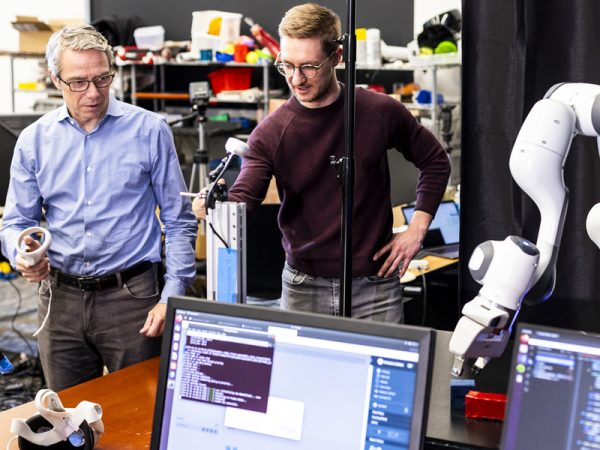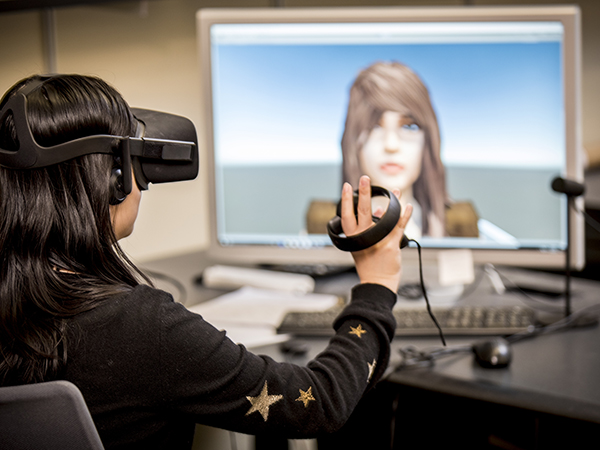Allen School researchers are at the forefront of exciting developments in AI spanning machine learning, computer vision, natural language processing, robotics and more.
We cultivate a deeper understanding of the science and potential impact of rapidly evolving technologies, such as large language models and generative AI, while developing practical tools for their ethical and responsible application in a variety of domains — from biomedical research and disaster response, to autonomous vehicles and urban planning.
Research Groups & Labs
Accessible Accordion
Areas of Expertise
Societal Impact
Results will appear in alphabetical order.

AIMS Lab
The AI for bioMedical Sciences (AIMS) Lab fundamentally advances the way AI is integrated with biology and clinical medicine by addressing novel scientific questions spanning explainable AI, model auditing, disease drivers, and more.

Behavioral Data Science Group
The Behavioral Data Science Group leverages large-scale behavioral data to extract actionable insights about our lives, health and happiness by combining techniques from data science, social network analysis, and natural language processing.
Bespoke Silicon Group
The Bespoke Silicon Group aims to bring hardware design to its highest art and rapidly conceive of, design and implement entirely new kinds of hardware faster than has ever been done before.

Database Group
The Database Group advances both theoretical and systems work in probabilistic databases, stream processing, sensor-based monitoring, databases and the web, XML, image/video data management, data management for machine learning, data mining and more.

Golub Lab
The Golub Lab develops computational models and algorithms for understanding how single-trial neural population activity drives our abilities to generate movements, make decisions, and learn from experience.

Graphics & Imaging Lab (GRAIL)
The work of the Graphics & Imaging Laboratory spans computer graphics, computer vision, generative AI, computational photography, virtual reality, animation and games.

H2 Lab
The H2 Lab addresses foundational problems in Artificial Intelligence and Natural Language Processing to develop general-purpose AI algorithms that represent, comprehend, and reason about diverse forms of data at large scale.

Human-Centered Robotics Lab
In the Human-Centered Robotics lab we aim to develop robotics that are useful and usable for future users of task-oriented robots.

Interactive Data Lab
The Interactive Data Lab aims to enhance people’s ability to understand and communicate data through the design of new interactive systems for data visualization and analysis.

Makeability Lab
The Makeability Lab specializes in Human-Computer Interaction and applied machine learning for high-impact problems in accessibility, computational urban science, and augmented reality.

Mobile Intelligence Lab
The interdisciplinary Mobile Intelligence Lab builds intelligent systems and tools for tackling hard technical and societal problems, including battery-free computing, medical diagnostics, augmented human perception and more.

Mostafavi Lab
The Mostafavi Lab develops machine learning and statistical methods that combine evidence across multiple types of molecular/genomics data and disentangle spurious from meaningful correlations for new insights into mechanisms of health and disease.

Neural Systems Lab
The Neural Systems Lab at the UW focuses on understanding the brain using computational models and simulations, and applying this knowledge to the task of developing human-like artificial intelligence (AI) and brain-computer interfaces (BCIs).

Personal Robotics Lab
Our mission is to develop the fundamental building blocks of perception, manipulation, learning, and human-robot interaction to enable robots to perform complex physical manipulation tasks under clutter and uncertainty with and around people.

RAIVN Lab
The Reasoning, AI, and VisioN (RAIVN) Lab directed by Prof. Ali Farhadi and Prof. Ranjay Krishna focuses at the intersection of computer vision, machine learning, natural language processing and robotics and is targeted towards helping computers…

Robot Learning Lab
The Robot Learning Lab works on foundational research in machine learning, AI and robotics to develop intelligent robotic systems that can perceive, plan and act in complex environments and improve performance with experience.

Robotics and State Estimation Lab
We are interested in the development of computing systems that interact with the physical world in an intelligent way. To investigate such systems, we focus on problems in robotics and activity recognition.

Robotics Group
Doing ground-breaking work in mechanism design, sensors, computer vision, robot learning, Bayesian state estimation, control theory, numerical optimization, biomechanics, neural control of movement, computational neuroscience, brain-machine interfaces, natural language…

SAMPL
SAMPL is an interdisciplinary machine learning research group exploring problems across the system stack, including deep learning frameworks, specialized hardware for training and inference, new intermediate representations and more.

Sensor Systems Laboratory
The Sensor Systems Laboratory invents new sensor systems, devises new ways to power and communicate with them, and develops algorithms for using them, with applications in the domains of bioelectronics, robotics, and ubiquitous computing.

Social RL Lab
The Social RL Lab aims to leverage social information in human-AI and multi-agent interactions to enable AI to learn complex behavior, rapidly adapt to new circumstances and cooperate to achieve joint goals—similarly to how humans and animals learn.

Tsvetshop
Tsvetshop researchers aim to develop practical solutions to natural language processing problems that combine sophisticated learning and modeling methods with insights into human languages and the people who speak them.

UbiComp Lab
The Ubiquitous Computing (UbiComp) Lab develops innovative systems for health sensing, low-power sensing, energy sensing, activity recognition and novel user interface technology for real-world applications.

UW NLP Group
The University of Washington Natural Language Processing Group comprises diverse researchers across campus collaborating in the study of all aspects of NLP from computational, engineering, linguistic, social, statistical, and other perspectives.

UW Reality Lab
The UW Reality Lab advances the state of the art in virtual and augmented reality by developing new technologies and applications, educating the next generation of researchers and technologists, and supporting robust collaborations with industry.

WEIRD Lab
The Washington Embodied Intelligence and Robotics Development lab is interested in robotics problems, and currently we are thinking deeply about reinforcement learning algorithms to enable real-world robotic manipulation tasks in the home.
Highlights
UW News

In this Q&A, Allen School professor Sheng Wang talks about his work on a new medical AI model, BiomedParse, that works across nine different types of medical images to better predict systemic diseases. Clinicians can load images into the system and ask questions in plain English.
GeekWire

OctoAI, a UW startup that sells tools to help build and run generative AI models more efficiently, has been acquired by chip giant Nvidia. Allen School professor and OctoAI co-founder Luis Ceze joined Nvidia following the deal, which is the latest AI-related acquisition for the chipmaker.
UW News

Allen School postdoc Niloofar Mireshghallah discusses why math and reasoning have so challenged artificial intelligence models and what the public should know about OpenAI’s new release.
